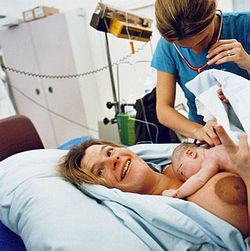Lurestan Fibula (4484325444)
Luristan bronze, disk pin showing a woman giving birth between 2 antelopes, ornamented with flowers, Iranian iron age (1000 to 650 BCE) at the Louvre museum, Paris, France, March 2010.
The name “canonical bronze of Luristan” refers to a set of objects testifying of the original culture of a nomadic civilization who lived at the beginning of the iron age on the territory of the actual Iranian province of Lorestan (North West of the Zagros mountains). Its pastoral and nomadic way of life explain the lack of architectural remnants left, the few artefacts found being almost funeral objects found after graves were looted or excavated by archaeologists. These objects were made in one time almost in bronze using the lost-wax casting. It consist in axes, horse bytes, maces, fibulas, or swords whom style and ornaments are typical, testifying of the originality of such civilization and great savoir-faire of its craftsmen.
Read more : B. Overlaet on Encyclopédia Iranica
Bronze du Lorestan, fibule représentant une femme accouchant entre deux antilopes, ornée de fleurs, âge du fer iranien (1500 à 700 BCE) au musée du Louvre, Paris, France, Mars 2010.
La dénomination « bronzes canoniques du Lorestan » se rapporte à un ensemble d’objets témoignant de la culture originale d’une civilisation nomadique ayant vécu au début de l’âge du fer sur le territoire de l’actuelle province iranienne du Lorestan (Nord-Ouest des monts Zagros). Son mode de vie nomadique et pastoral explique l’absence de traces architecturale laissées, les quelques artefacts retrouvés consistant quasi uniquement en des objets funéraires retrouvés lors de pillages de tombes ou d’excavations archéologiques de cimetières. L’essentiel des objets sont réalisés d’un seul tenant, le plus souvent en bronze moulé à la cire perdue. Il s’agit de haches, masses, mors de chevaux, fibules, ou dagues, dont style et ornements sont caractéristiques et dont la richesse témoigne de l’originalité de cette culture et du savoir-faire de ses artisans.
En savoir plus: B. Overlaet sur Encyclopédia Iranica (en Anglais)Relevantní obrázky
Relevantní články
PorodPorod dítěte je zakončení těhotenství, kdy jedno nebo více dětí opouští dělohu průchodem pochvou nebo císařským řezem. V roce 2018 se narodilo na celém světě asi 136 milionů dětí. Většina porodů proběhne mezi 38. a 42. týdnem těhotenství. Předčasným porodem před 37. týdnem těhotenství se narodilo asi 15 milionů dětí, zatímco porodem po termínu se narodilo mezi 3 až 12 procenty dětí. V rozvinutém světě většina porodů proběhne v nemocnicích, zatímco v rozvojovém světě se většina porodů koná doma dle tradice s podporou porodní asistentky. .. pokračovat ve čtení

















